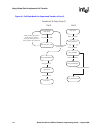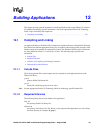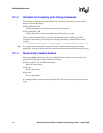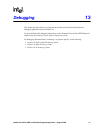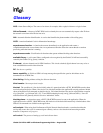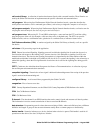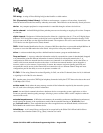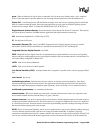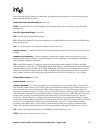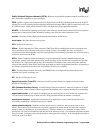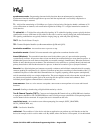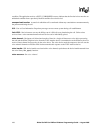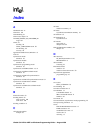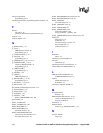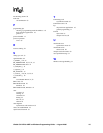
146 Global Call API for HMP on Windows Programming Guide — August 2006
glare: When an inbound call arrives while an outbound call is in the process of being setup, a glare condition
occurs. Unless the protocol specifies otherwise, the incoming call takes precedence over the outbound call.
Global Call: A unified, high-level API that shields developers from the low-level signaling protocol details that
differ in countries around the world. Allows the same application to easily work on multiple signaling systems
worldwide (for example, ISDN, T1 robbed bit, R2/MF, pulsed, SS7, IP H.323 etc.).
Digital Network Interface boards: Network interface boards that provide E1 and T1 interfaces. These boards
provide the physical interfaces for HMP software applications that require network connectivity.
IA5: International Alphabet No. 5 (defined by CCITT).
IE: See Information Element.
Information Element (IE): Used by the ISDN (Integrated Services Digital Network) protocol to transfer
information. Each IE transfers information in a standard format defined by CCITT standard Q.931.
Integrated Services Digital Network: See ISDN.
ISDN: Integrated Services Digital Network. An internationally accepted standard for voice, data, and signaling
that provides users with integrated services using digital encoding at the user-network interface. Also the name of a
call control library configured for Global Call.
LAPB: Link Access Protocol Balanced.
LAPD: Link Access Protocol on the D channel.
Line Device Identifier (LDID): A unique number that is assigned to a specific device or device group by Global
Call.
main thread: See thread.
multitasking functions: Functions that allow the software to perform concurrent operations. After being
initiated, multitasking functions return control to the application so that during the time it takes the function to
complete, the application program can perform other operations, such as servicing a call on another line device.
multithread asynchronous: see extended asynchronous.
network handle: SRL device handle associated with a network interface board or time slot; equivalent to the
device handle returned from the network library's dt_open( ) function.
network resource: Any device or group of devices that interface with the telephone network. Network resources
include digital network interface devices. Network resources are assigned to telephone lines (calls) on a dedicated
or a shared resource basis. Network resources control the signal handling required to manage incoming calls from
the network and the outgoing calls to the network.
NCAS: Non-Call Associated Signaling. Allows users to communicate by user-to-user signaling without setting up
a circuit-switched connection (this signal does not occupy B channel bandwidth). A temporary signaling
connection is established and cleared in a manner similar to the control of a circuit-switch connection. Since NCAS
calls are not associated with any B channel, applications receive and transmit NCAS calls on the D channel line



